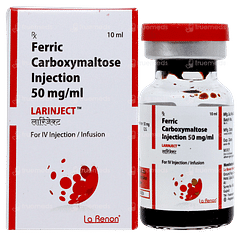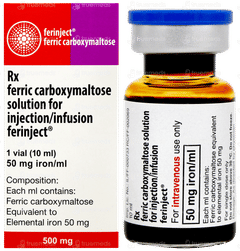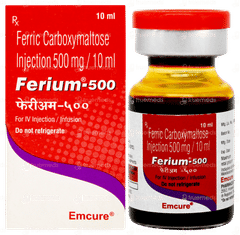Ferric Carboxymaltose
Uses of Ferric Carboxymaltose
The primary use of Ferric Carboxymaltose is to manage iron deficiency anaemia. It belongs to the group of iron replacement medicines.
In some countries, it is also approved for improving exercise capacity in adults with symptomatic heart failure and iron deficiency.
Side effects of Ferric Carboxymaltose
Nausea
Hypertension
Flushing
Reactions at the site of injection
Dizziness
How Ferric Carboxymaltose works
Ferric Carboxymaltose is a type of iron replacement medication.
It operates by acting as an iron (III) hydroxide complex with carboxymaltose, a carbohydrate polymer. This complex stabilizes the ferric ions and allows for the safe delivery of iron into the body.
Once administered, Ferric Carboxymaltose is absorbed by the reticuloendothelial system cells located in the liver, spleen and bone marrow.
The iron component breaks free from the complex and either enters the intracellular storage iron pool to transform into ferritin or gets transported to plasma transferrin. From there, it is delivered to red blood cell precursor cells to be incorporated into haemoglobin.
This activity aids in replenishing depleted iron levels and stimulates erythropoiesis, which is the production of red blood cells. The end result is an increase in healthy red blood cell count, helping to manage conditions of iron deficiency anaemia.
Certified content
Written By

BAMS, FMC, MD Resident
Reviewed By

Doctor of Medicine
Expert Advice
Dosage Forms Available
- Ferric Carboxymaltose is available as a dark brown, sterile, aqueous solution for administration via the intravenous route.
Age and Dose Restrictions
- This medication is intended for use in adults and in children aged 1 year and older.
Contraindications
- The use of Ferric Carboxymaltose is contraindicated in patients with known hypersensitivity to the medication or any of its excipients.
- It is also contraindicated in patients with a history of allergic disorders, including asthma, eczema or atopic allergies.
- Ferric Carboxymaltose should not be used in patients with anaemia not caused by iron deficiency, those with evidence of iron overload and patients who are less than 1 year old.
Other Medications to Avoid
- Ferric Carboxymaltose may interact with oral iron supplements as these may reduce the absorption of oral iron preparations.
- It can also interact with tetracyclines (doxycycline, minocycline) and fluoroquinolones (ciprofloxacin, ofloxacin), so these should be taken at least 1 hour before or 2 hours after Ferric Carboxymaltose administration.
Overdose and Missed Dose
- An overdose of Ferric Carboxymaltose may result in iron overload which can lead to various complications. If you suspect you have received an overdose, contact your doctor immediately.
- If you miss a dose of this medication, consult your doctor for advice on how to proceed.
Management of Side Effects
Most side effects are temporary and generally harmless and resolve after discontinuing this medicine. However, if you experience any severe side effects or worsening of any symptoms, please consult your doctor.
- Drinking plenty of fluids may help manage side effects such as dizziness.
- Resting after administration may help manage feelings of fatigue.
Use in Driving and Operating Machinery
- Ferric Carboxymaltose may cause dizziness or fainting. It is advised to avoid driving or operating heavy machinery if you experience these side effects.
Use in Pregnancy and Lactation
- The use of Ferric Carboxymaltose during pregnancy should be considered only if the potential benefit justifies the potential risk.
- Breastfed infants of mothers treated with Ferric Carboxymaltose should be monitored for gastrointestinal adverse effects.
Caution in Other Conditions
- Caution is advised when using Ferric Carboxymaltose in patients with acute or chronic infections, asthma, eczema, other atopic allergies, liver dysfunction or disease, systemic lupus erythematosus, and in patients with rheumatoid arthritis.
Special Dietary and Lifestyle Recommendations
- Maintaining a balanced diet rich in iron can help manage iron deficiency anaemia.
- Regular check-ups with your doctor are recommended to monitor your iron levels and adjust the dosage of Ferric Carboxymaltose as needed.
- Avoid alcohol consumption during treatment as alcohol can interfere with the absorption of iron.
- Maintain regular physical activity, as this can help promote the production of red blood cells.
- Remember that these recommendations are general in nature and you should always consult your doctor for personalised advice based on your condition and treatment plan.
Frequently asked questions
Is Ferric Carboxymaltose a steroid?
No, Ferric Carboxymaltose is not a steroid. It is an iron replacement medication that helps manage iron deficiency anaemia.
Can Ferric Carboxymaltose affect my mood or emotional state?
There is currently no evidence to suggest that Ferric Carboxymaltose directly impacts mood or emotion. However, managing anaemia can improve overall well-being and potentially boost mood.
Is Ferric Carboxymaltose safe to use for long periods of time?
Yes, Ferric Carboxymaltose is typically safe for long-term use under the supervision of a doctor. However, it is crucial to have regular blood tests to monitor your iron levels and adjust dosages accordingly.
Can Ferric Carboxymaltose cause weight gain?
There is no documented evidence to suggest that Ferric Carboxymaltose causes weight gain. If you notice unexplained changes in your body weight whilst taking this medicine, consult your doctor.
Does Ferric Carboxymaltose have any effects on the menstrual cycle?
There are no documented effects of Ferric Carboxymaltose on the menstrual cycle. If you notice any changes in your menstrual cycle while using this medicine, consult your doctor.
What should I do if I have an allergic reaction to Ferric Carboxymaltose?
If you experience an allergic reaction such as rash, itching or difficulty breathing after receiving Ferric Carboxymaltose, seek immediate medical attention.
Are there any natural alternatives to Ferric Carboxymaltose?
While foods rich in iron such as red meat, beans, and fortified cereals can help manage mild iron deficiency, they may not be sufficient for severe cases of anaemia where rapid replenishment of iron stores is needed. Always consult your doctor for advice tailored to your specific needs.
List of Medicines for Ferric Carboxymaltose








Company
About UsHealth ArticleHealth StoriesDiseases & Health ConditionsAyurvedaAll MedicinesAll BrandsNeed HelpFAQSubscribe
Registered Office Address
Grievance Officer
Download Truemeds
Contact Us
Our customer representative team is available 7 days a week from 9 am - 9 pm.
v4.3.8
2025 - Truemeds | All rights reserved. Our content is for informational purposes only. See additional information.
Our Payment Partners










